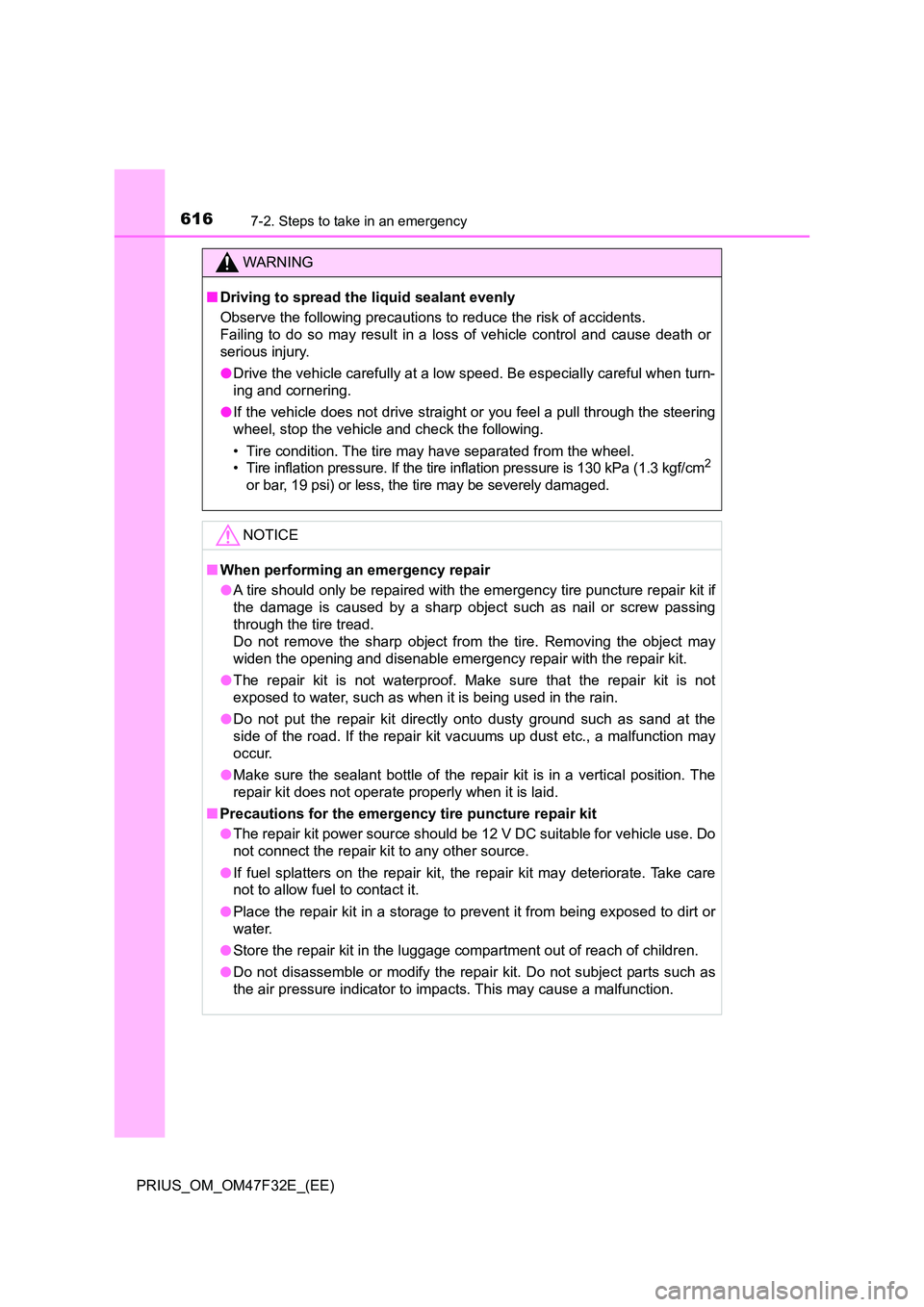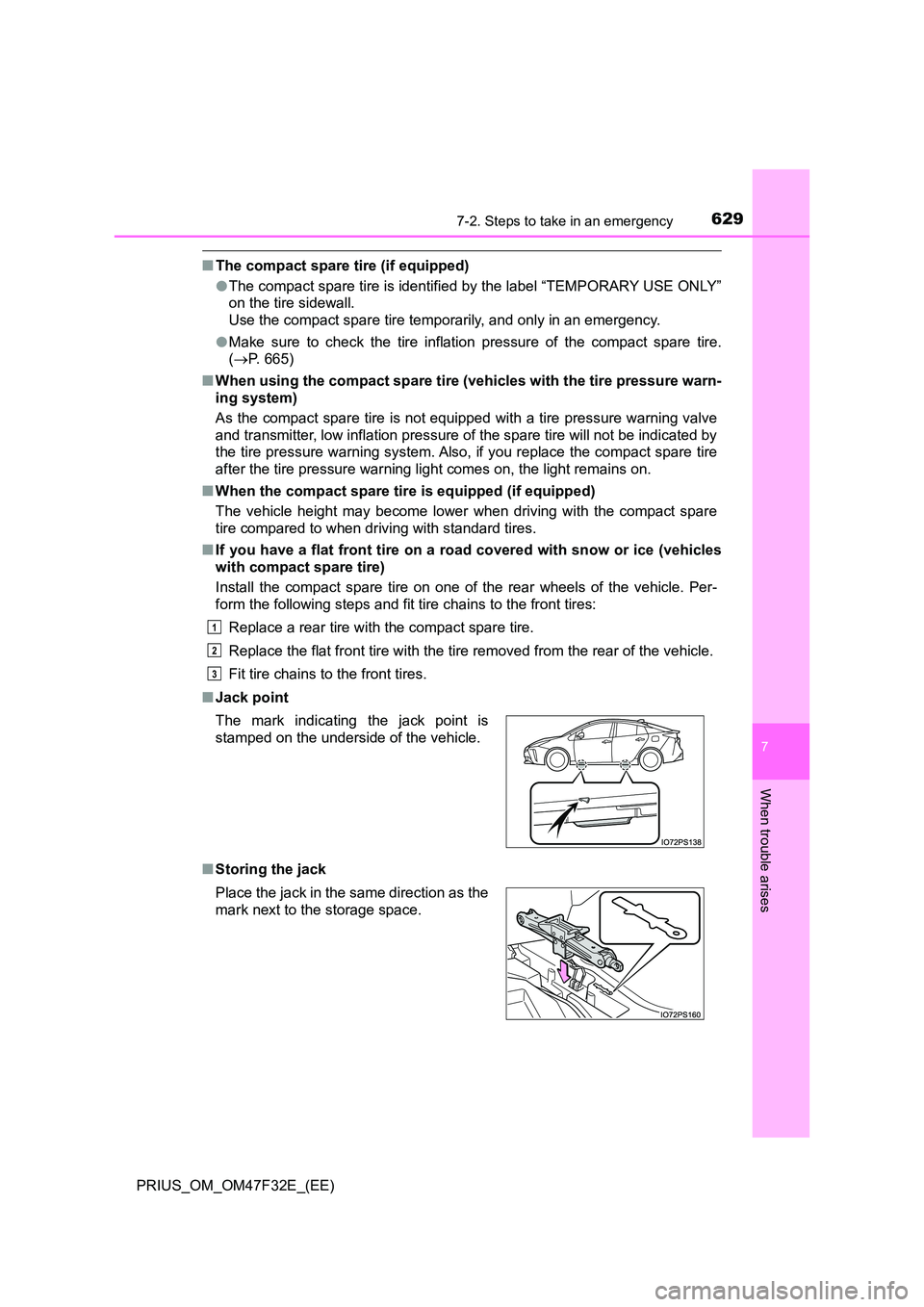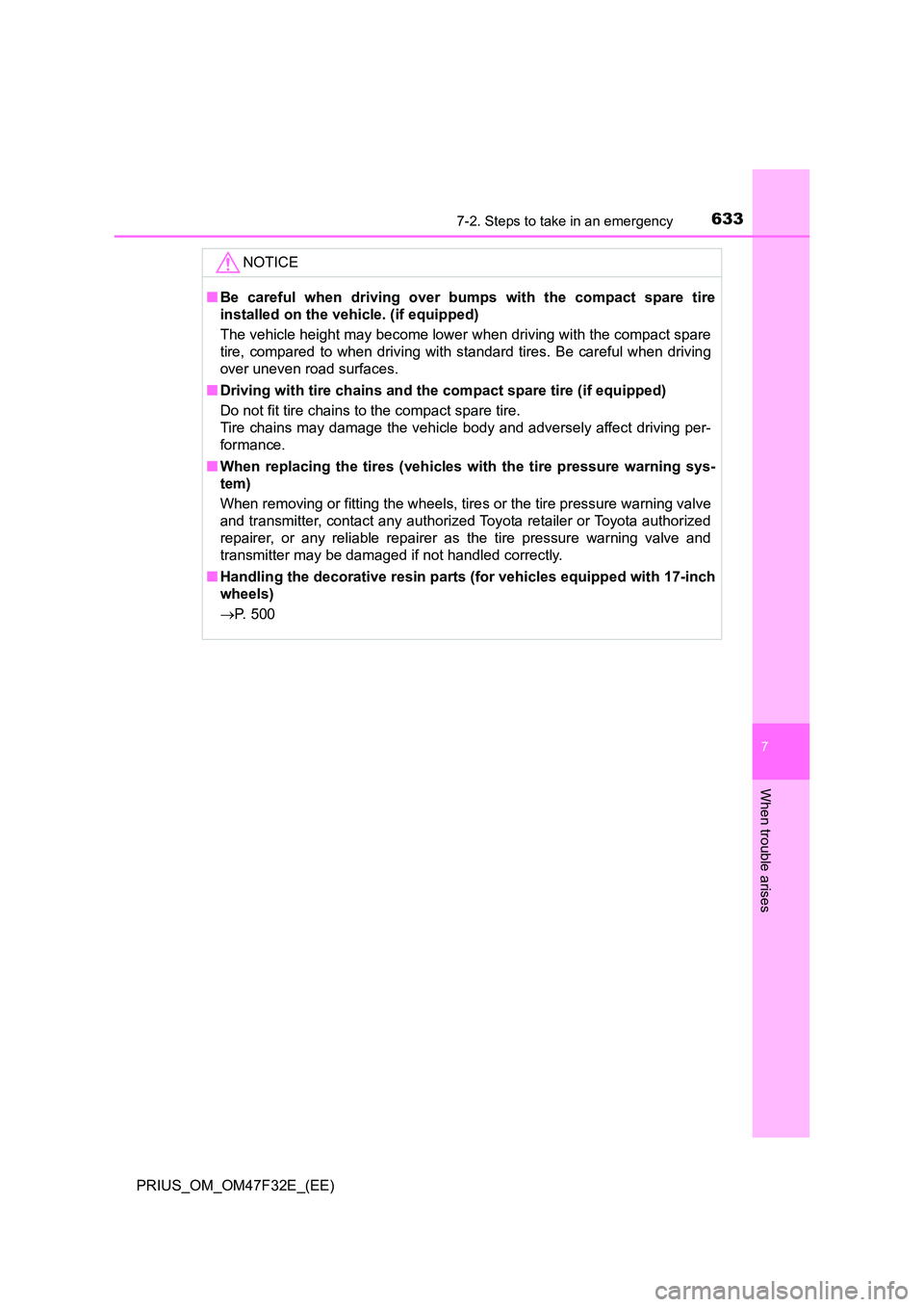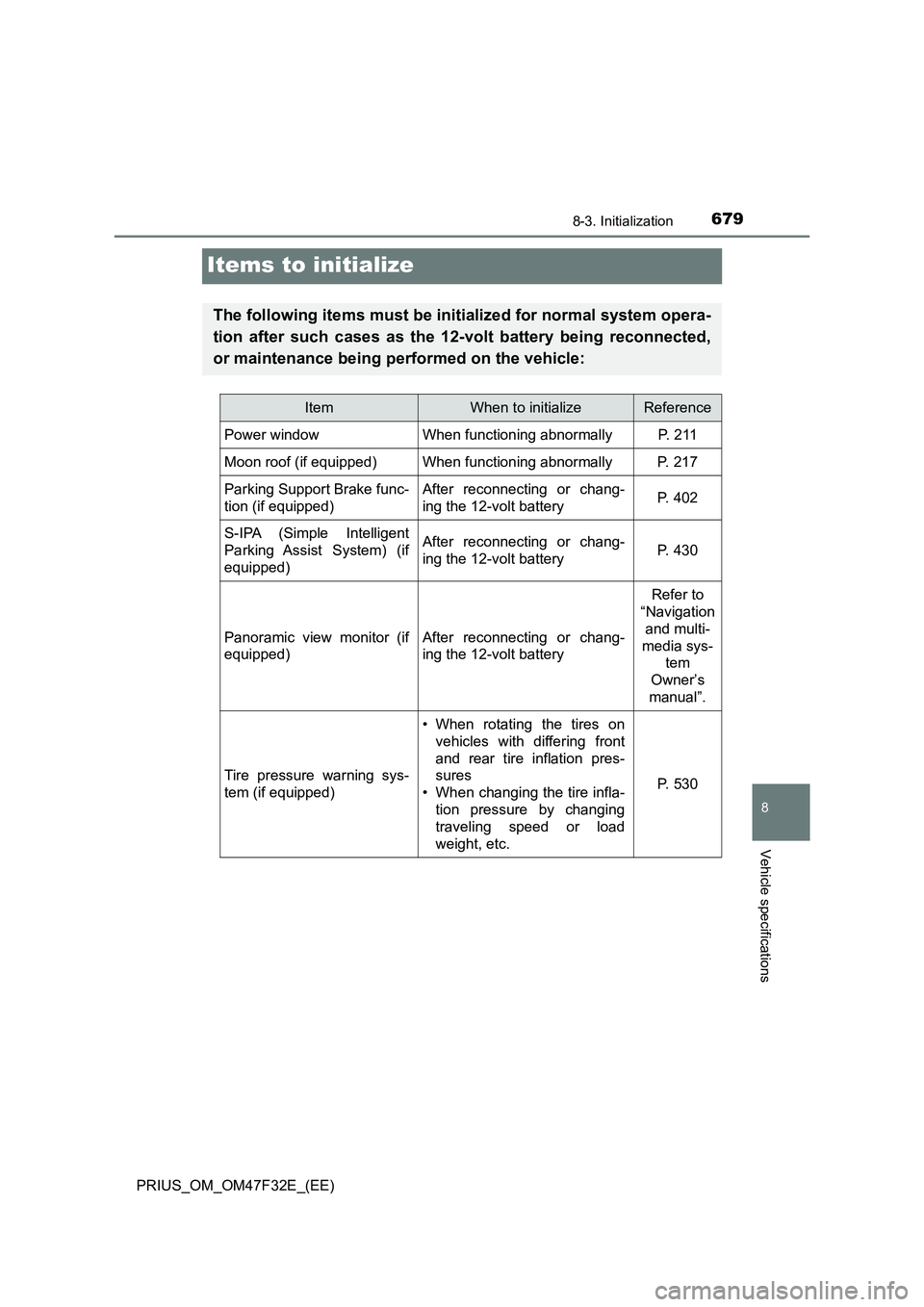Page 618 of 770

6167-2. Steps to take in an emergency
PRIUS_OM_OM47F32E_(EE)
WARNING
■Driving to spread the liquid sealant evenly
Observe the following precautions to reduce the risk of accidents.
Failing to do so may result in a loss of vehicle control and cause death or
serious injury.
● Drive the vehicle carefully at a low speed. Be especially careful when turn-
ing and cornering.
● If the vehicle does not drive straight or you feel a pull through the steering
wheel, stop the vehicle and check the following.
• Tire condition. The tire may have separated from the wheel.
• Tire inflation pressure. If the tire inflation pressure is 130 kPa (1.3 kgf/cm2
or bar, 19 psi) or less, the tire may be severely damaged.
NOTICE
■ When performing an emergency repair
● A tire should only be repaired with the emergency tire puncture repair kit if
the damage is caused by a sharp object such as nail or screw passing
through the tire tread.
Do not remove the sharp object from the tire. Removing the object may
widen the opening and disenable emergenc y repair with the repair kit.
● The repair kit is not waterproof. Make sure that the repair kit is not
exposed to water, such as when it is being used in the rain.
● Do not put the repair kit directly onto dusty ground such as sand at the
side of the road. If the repair kit vacuums up dust etc., a malfunction may
occur.
● Make sure the sealant bottle of the repair kit is in a vertical position. The
repair kit does not operate properly when it is laid.
■ Precautions for the emergency tire puncture repair kit
● The repair kit power source should be 12 V DC suitable for vehicle use. Do
not connect the repair kit to any other source.
● If fuel splatters on the repair kit, the repair kit may deteriorate. Take care
not to allow fuel to contact it.
● Place the repair kit in a storage to prevent it from being exposed to dirt or
water.
● Store the repair kit in the luggage compartment out of reach of children.
● Do not disassemble or modify the repair kit. Do not subject parts such as
the air pressure indicator to impacts. This may cause a malfunction.
Page 619 of 770
6177-2. Steps to take in an emergency
PRIUS_OM_OM47F32E_(EE)
7
When trouble arises
NOTICE
■To avoid damage to the tire pressure warning valves and transmitters
(vehicles with the tire pressure warning system)
When a tire is repaired with liquid sealants, the tire pressure warning valve
and transmitter may not operate properly. If a liquid sealant is used, contact
any authorized Toyota retailer or Toyota authorized repairer, or any reliable
repairer or other qualified service shop as soon as possible. After use of liq-
uid sealant, make sure to replace the tire pressure warning valve and trans-
mitter when repairing or replacing the tire. ( P. 530)
Page 631 of 770

6297-2. Steps to take in an emergency
PRIUS_OM_OM47F32E_(EE)
7
When trouble arises
■The compact spare tire (if equipped)
● The compact spare tire is identified by the label “TEMPORARY USE ONLY”
on the tire sidewall.
Use the compact spare tire temporarily, and only in an emergency.
● Make sure to check the tire inflation pressure of the compact spare tire.
( P. 665)
■ When using the compact spare tire (vehicles with the tire pressure warn-
ing system)
As the compact spare tire is not equipped with a tire pressure warning valve
and transmitter, low inflation pressure of the spare tire will not be indicated by
the tire pressure warning system. Also, if you replace the compact spare tire
after the tire pressure warning light comes on, the light remains on.
■ When the compact spare tire is equipped (if equipped)
The vehicle height may become lower when driving with the compact spare
tire compared to when driving with standard tires.
■ If you have a flat front tire on a road covered with snow or ice (vehicles
with compact spare tire)
Install the compact spare tire on one of the rear wheels of the vehicle. Per-
form the following steps and fit tire chains to the front tires:
Replace a rear tire with the compact spare tire.
Replace the flat front tire with the tire removed from the rear of the vehicle.
Fit tire chains to the front tires.
■ Jack point
■ Storing the jack
The mark indicating the jack point is
stamped on the underside of the vehicle.
Place the jack in the same direction as the
mark next to the storage space.
1
2
3
Page 635 of 770

6337-2. Steps to take in an emergency
PRIUS_OM_OM47F32E_(EE)
7
When trouble arises
NOTICE
■Be careful when driving over bumps with the compact spare tire
installed on the vehicle. (if equipped)
The vehicle height may become lower w hen driving with the compact spare
tire, compared to when driving with st andard tires. Be careful when driving
over uneven road surfaces.
■ Driving with tire chains and the compact spare tire (if equipped)
Do not fit tire chains to the compact spare tire.
Tire chains may damage the vehicle body and adversely affect driving per-
formance.
■ When replacing the tires (vehicles with the tire pressure warning sys-
tem)
When removing or fitting the wheels, tire s or the tire pressure warning valve
and transmitter, contact any authorized Toyota retailer or Toyota authorized
repairer, or any reliable repairer as the tire pressure warning valve and
transmitter may be damaged if not handled correctly.
■ Handling the decorative resin parts (for vehicles equipped with 17-inch
wheels)
P. 500
Page 667 of 770
6658-1. Specifications
PRIUS_OM_OM47F32E_(EE)
8
Vehicle specifications
15-inch tires (vehicles without full-size spare tire)
15-inch tires (vehicles with full-size spare tire)
17-inch tires
Tires and wheels
Tire size195/65R15 91H
Tire inflation pressure
(Recommended cold tire
inflation pressure)Front250 kPa (2.5 kgf/cm2 or bar, 36 psi)
Rear240 kPa (2.4 kgf/cm2 or bar, 35 psi)
Wheel size15 6 1/2J
Wheel nut torque103 N•m (10.5 kgf•m, 76 ft•lbf)
Tire size195/65R15 91H
Tire inflation pressure
(Recommended cold tire
inflation pressure)Front
220 kPa (2.2 kgf/cm2 or bar, 32 psi)
Rear
Wheel size15 6 1/2J
Wheel nut torque103 N•m (10.5 kgf•m, 76 ft•lbf)
Tire size215/45R17 87W
Tire inflation pressure
(Recommended cold tire
inflation pressure)Front220 kPa (2.2 kgf/cm2 or bar, 32 psi)
Rear210 kPa (2.1 kgf/cm2 or bar, 30 psi)
Wheel size17 7J
Wheel nut torque103 N•m (10.5 kgf•m, 76 ft•lbf)
Page 668 of 770
6668-1. Specifications
PRIUS_OM_OM47F32E_(EE)
Compact spare tire (if equipped)
■When towing a trailer*
Add 20.0 kPa (0.2 kgf/cm2 or bar, 3 psi) to the recommended tire inflation
pressure and drive at speeds below 100 km/h (62 mph).
*: Vehicles that can tow a trailer. (P. 233)
Tire sizeT125/70D17 98M
Tire inflation pressure
(Recommended cold tire
inflation pressure)
420 kPa (4.2 kgf/cm2 or bar, 60 psi)
Wheel size17 4T
Wheel nut torque103 N•m (10.5 kgf•m, 76 ft•lbf)
Page 679 of 770
6778-2. Customization
PRIUS_OM_OM47F32E_(EE)
8
Vehicle specifications
■Illumination (P. 470)
■Maintenance system
*: If equipped
FunctionDefault
settingCustomized
setting
Time elapsed before the inte-
rior lights turn off15 secondsOff
–OO 7.5 seconds
30 seconds
Operation after the power
switch is turned offOnOff––O
Operation when the doors are
unlockedOnOff––O
Operation when you approach
the vehicle with the electronic
key on your person
OnOff––O
Footwell lighting On Off – – O
Interior lights illumination con-
trolOn Off – – O
123
Tire pressure warning
system
*
Initializing the tire pressure warning system:
P. 530
Page 681 of 770

6798-3. Initialization
PRIUS_OM_OM47F32E_(EE)
8
Vehicle specifications
Items to initialize
The following items must be initialized for normal system opera-
tion after such cases as the 12-volt battery being reconnected,
or maintenance being performed on the vehicle:
ItemWhen to initializeReference
Power windowWhen functioning abnormallyP. 2 11
Moon roof (if equipped)When functioning abnormallyP. 217
Parking Support Brake func-
tion (if equipped)After reconnecting or chang-
ing the 12-volt batteryP. 402
S-IPA (Simple Intelligent
Parking Assist System) (if
equipped)After reconnecting or chang-
ing the 12-volt batteryP. 430
Panoramic view monitor (if
equipped)After reconnecting or chang-
ing the 12-volt battery
Refer to
“Navigation
and multi-
media sys-
tem
Owner’s
manual”.
Tire pressure warning sys-
tem (if equipped)
• When rotating the tires on
vehicles with differing front
and rear tire inflation pres-
sures
• When changing the tire infla-
tion pressure by changing
traveling speed or load
weight, etc.
P. 530